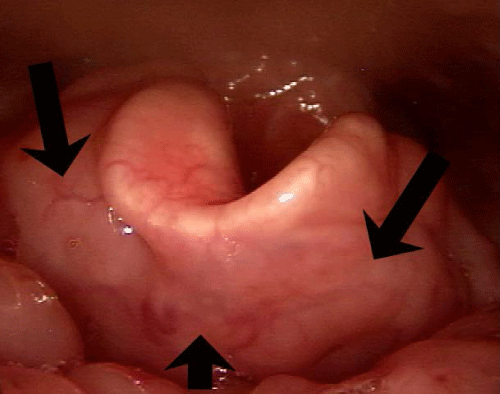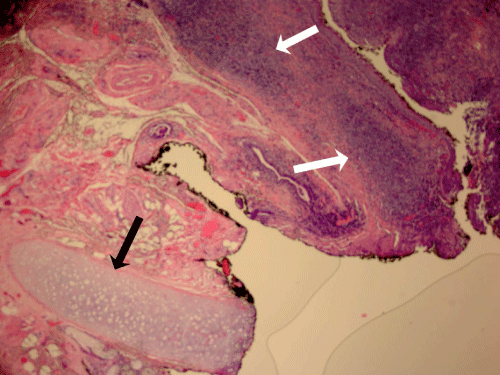Heterotopic Epiglottic Lymphoid Tissue (HELT) Causing Recurrent Epiglottitis
Received: 07-Feb-2014 / Accepted Date: 04-Apr-2014 / Published Date: 11-Apr-2014 DOI: 10.4172/2161-119X.1000168
Abstract
Problem: A unique case of recurrent infectious epiglottitis in an immunocompetent, fully immunized, non-syndromic 23 year old female.
Method: Case report
Results: Patient was successfully managed with an endoscopic partial epiglottectomy at two years of follow-up. Pathology revealed what appears to be sub-mucosal germinally-active heterotropic lymphoid tissue within the epiglottic soft tissues as the likely cause of the recurrent epiglottitis.
Conclusions: The embryology of the lingual tonsils and epiglottis may provide a clue to the etiology of this case. Heterotrophic epiglottic lymphoid tissue may be considered a newly described, clinically significant congenital laryngeal anomaly that may not present until adulthood and should be considered in rare cases of recurrent infectious epiglottitis.
Keywords: Epiglottis, Epiglottitis, Lingual tonsils, Congenital laryngeal anomaly, Lymph tissue
246349Introduction
We present a case of recurrent epiglottitis necessitating recurrent urgent endotracheal intubations and ICU observation due to Heterotopic Epiglottic Lymphoid Tissue (HELT) in an immunocompetent, fully immunized, otherwise healthy 23 year old female.
Case Report
A 23 year old fully immunized non-snydromic immunocompetent female presented after 4 episodes of acute epiglottitis at an outside institution that required intubation for airway control, antibiotics, steroids and ICU observation. The clinical diagnosis of acute epiglottitis was made by flexible fiberoptic laryngoscopy in the emergency department each time, with classic findings including an erythematous and edematous epiglottis, with airway obstruction.These 4 episodes occurred over a period of 18 months. Following the second episode a tracheotomy versus lingual tonsillectomy was advised. The patient refused both and presented for a second opinion.
Office laryngoscopy while asymptomatic revealed a large band-like sub-mucosal bulge on the lingual surface of the epiglottis, distinct from moderately hypertrophic-appearing lingual tonsils with preservation of the vallecula (Figure 1). The patient underwent an endoscopic partial epiglottectomy without lingual tonsillectomy. The final pathology demonstrated squamous mucosa with chronic inflammation and benign appearing lymphoid hyperplasia with reactive germinal centers (Figure 2). Flow cytometry was negative. Tonsillar crypts were not identified. Tissue cultures grew Group A streptococcus.
At follow-up, the extent of the epiglottic resection seemed to be adequate to mitigate airway involvement in the event of another episode of epiglottitis, and the patient had no dysphagia or aspiration. The patient was followed closely for two years.During this time, she had a single episode of odynophagia with negative laryngoscopy and no airway complaints.The episode was managed without hospitalization utilizing oral antibiotics and prophylactic steroids with resolution after five days.
Discussion
Congenital anomalies of the larynx are relatively rare with the epiglottis representing one of the less commonly affect sites.The most commonly reported congenital epiglottic deformity is a bifid epiglottis, which is considered to be more of a syndromic constituent rather than an isolated anomaly, frequently associated with polydactyl [1]. Most of the commonly recognized congenital laryngeal anomalies cause airway problems. The majority of these congenital laryngeal anomalies is due to structural deformity and present in infancy.The present case represents an unusual adult presentation of a congenital laryngeal anomaly.
The entire respiratory tree is an outgrowth of the primitive pharynx. The embryology of Waldeyer’s Ring is complicated and involves participation of several components of the bronchial apparatus [2]. The lingual tonsils form in concert with the posterior third of the tongue, derived from the hyobranchial eminence. The hyobranchial eminence is surrounded by infiltrating lymphoid cells, gradually leading to the appearance of the lingual tonsils. The primitive epiglottis is first seen around day 15. The hyobranchial eminence is purported as being the chief precursor of the epiglottis as well; however some controversy exists as to whether it is the sole anlage or not [3]. Regardless of the controversy, the hyobranchial eminence appears to play an important role in both the lingual tonsils and epiglottis. It is plausible to theorize a case of heterotopic infiltration of some of the lymphoid tissue from the adjacent developing lingual tonsils into the epiglottic anlage accounting for the case described here. It is also conceivable that this is not an uncommon event. Small aggregates of lymphoid tissue have been described throughout the pharynx [2]. If small sub-mucosal aggregates of heterotopic lymphoid tissue without crypts are the norm for this particular anomaly, most would be expected to be asymptomatic. Having a large enough aggregate of Heterotopic Epiglottic Lymphoid Tissue (HELT) sufficient in size to be clinically symptomatic with chronic predisposing lingual tonsillitis may be the necessary preconditions for the rare case of relapsing bacterial epiglottitis presented.
There have been scattered case reports regarding chronic or recurrent lingual tonsillitis. In a single case report the condition resulted in recurrent epiglottitis successfully managed with lingual tonsillectomy [4]. This patient did not require a lingual tonsillectomy, but instead underwent an endoscopic laser partial epiglottectomy to remove the majority of the large mass of what was ultimately was determined to be heterotopic epiglottic lymphoid tissue.
Conclusion
The lingual tonsils and epiglottis are thought to be derived from, or closely related to, the hyobranchial eminence. Aberrant migration of lymphoid tissue intended for the posterior third of the tongue and future lingual tonsils during embryogenesis may result in Heterotopic Epiglottic Lymphoid Tissue (HELT) that is clinically significant by being susceptible to the same infectious processes as the lingual tonsils except for the greater potential for airway involvement. HELT may be considered along the range of congenital laryngeal anomalies; however additional cases would be necessary to support this position.
References
- Tsurumi H, Ito M, Ishikura K, Hataya H, Ikeda M, et al. (2010) Bifid epiglottis: syndromic constituent rather than isolated anomaly. PediatrInt 52: 723-728.
- Goeringer GC, Vidić B (1987) The embryogenesis and anatomy of Waldeyer's ring. OtolaryngolClin North Am 20: 207-217.
- Rizk HG, Nassar M, Rohayem Z, Rassi SJ (2010) Hypoplastic epiglottis in a non-syndromic child: a rare anomaly with serious consequences. Int J PediatrOtorhinolaryngol 74: 952-955.
- Wilson JF, Coutras S, Tami TA (1989) Recurrent adult acute epiglottitis: the role of lingual tonsillectomy. Ann OtolRhinolLaryngol 98: 602-604.
Citation: Haben CM, Liu D (2014) Heterotopic Epiglottic Lymphoid Tissue (HELT) Causing Recurrent Epiglottitis. Otolaryngology 4:168. DOI: 10.4172/2161-119X.1000168
Copyright: © 2014 Haben CM et al. This is an open-access article distributed under the terms of the Creative Commons Attribution License, which permits unrestricted use, distribution, and reproduction in any medium, provided the original author and source are credited.
Share This Article
Recommended Journals
Open Access Journals
Article Tools
Article Usage
- Total views: 17370
- [From(publication date): 8-2014 - Apr 06, 2025]
- Breakdown by view type
- HTML page views: 12697
- PDF downloads: 4673


